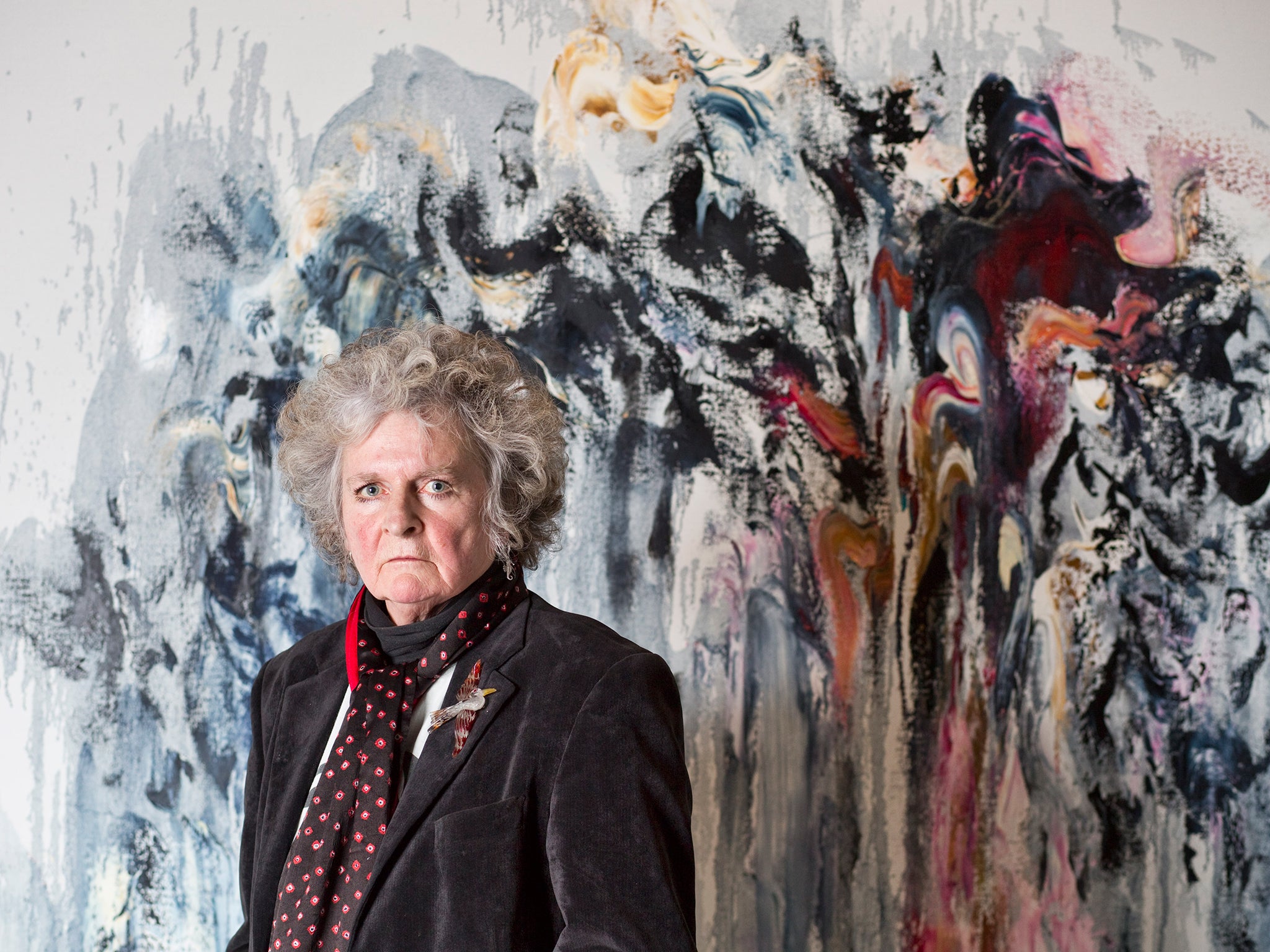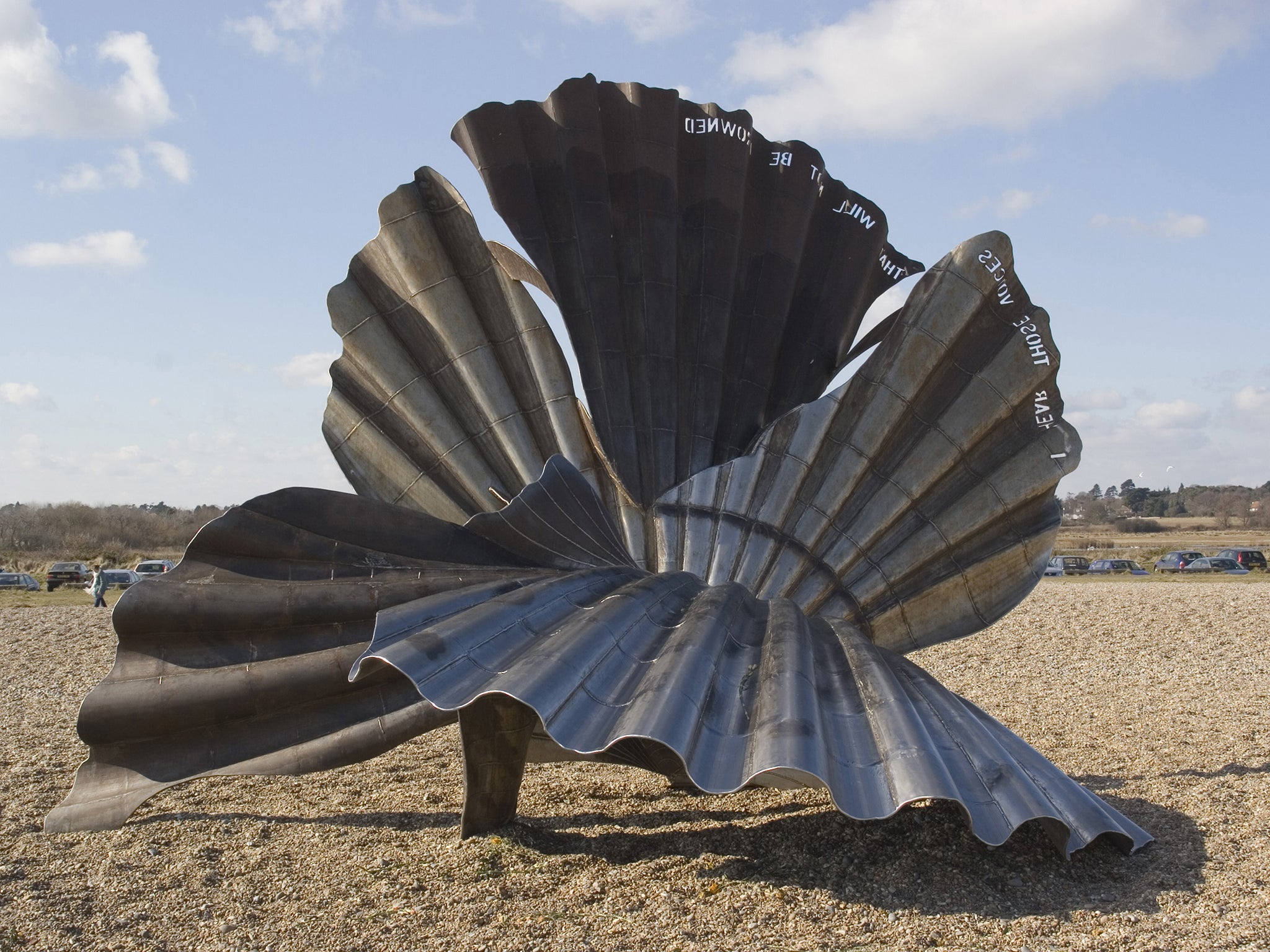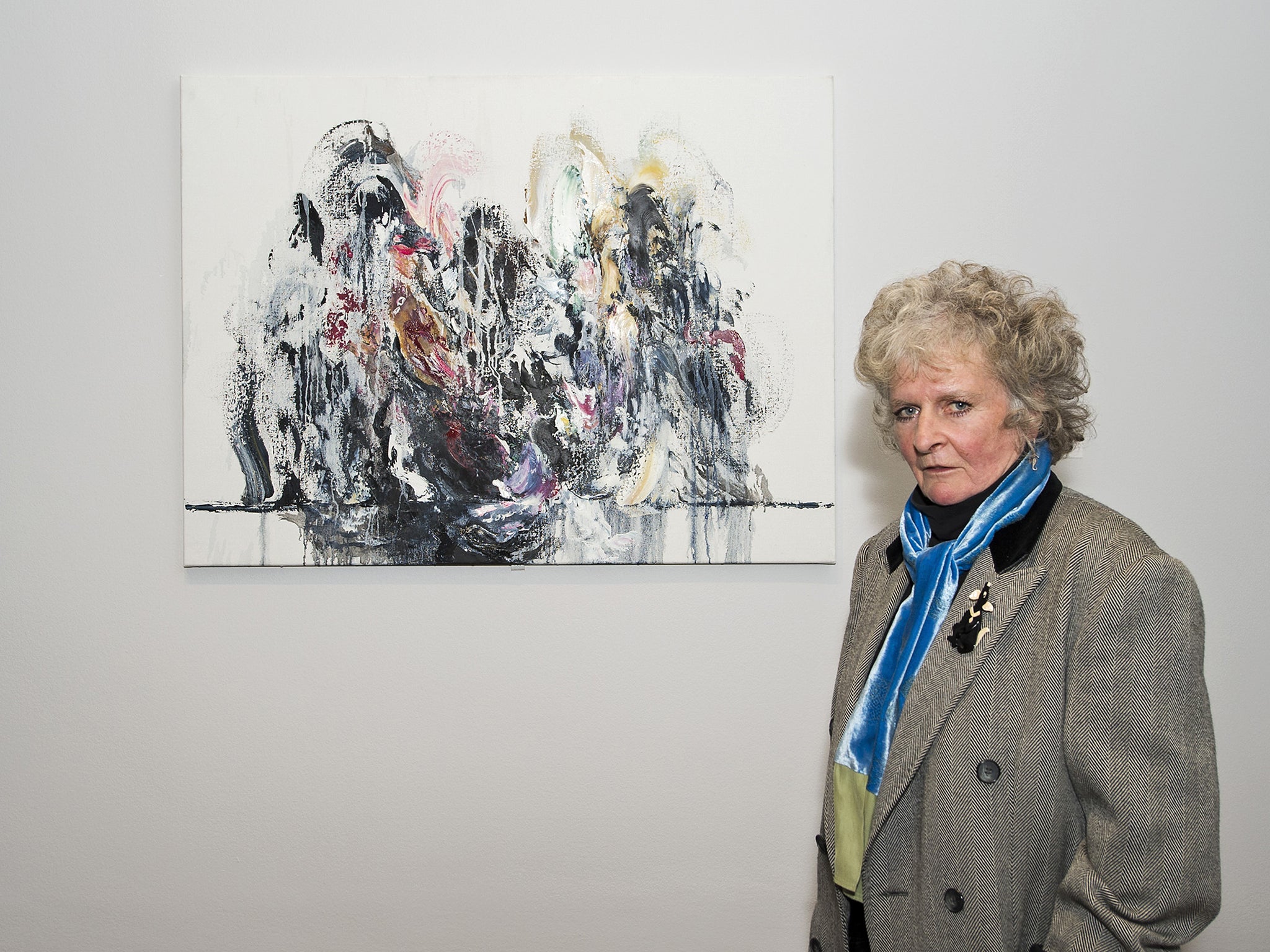Maggi Hambling interview: Celebrated artist on how she discovered her talent for painting – and the sting of criticism
For many years an outspoken public artist on the television and radio, she also makes art that moves people deeply

She stares like a hawk preparing to swoop: Maggi Hambling, artist and sculptor – a national treasure to many, a mystery to some – is standing in the car park of a Suffolk railway station, looking like Bob Dylan’s wilder sister, with a bird’s- nest shock of white hair and those startling sea-blue eyes, fierce in the winter gloom.
“She’s called Marilyn,” says Hambling, in a blue body-warmer and paint-splatted sweatshirt, as she climbs into a gloriously over-the-top white-and-burgundy Chrysler. It takes a moment to realise that she means the car. “She used to be black until I had her pimped.”

That’s a glorious word to hear from a voice so posh it suits a Commander of the British Empire. At the age of 70, Hambling is one of Britain’s most celebrated – and divisive – contemporary artists: the first in residence at the National Gallery, in 1980; the winner of the Jerwood Painting Prize in 1995; lauded for unflinching portraits of her mother, father and muse on their death beds; now best known for her sculpture, Scallop, on a Suffolk beach and for huge canvases of the sea. Her Walls of Water exhibition at the National Gallery was described as “magnificent” by critics who were swept away by the “sheer energy” and “sense of life” in her vast, dizzying paintings of the waves. But not everyone liked them. “Hambling is proof you can be a well-known artist without having a soul, a brain or a good eye,” said one lacerating review. “She’ll try anything for effect.”
Her car is certainly unmissable, as it glides through the tight, muddy lanes. “This is the wild side of Suffolk.” The personalised number plate is a jolly message containing the word “gay”. She is among those “long-time champions” of lesbian, gay, bisexual, transgender and intersex rights who would dominate The Independent on Sunday’s Rainbow List every year, if we didn’t give them a special status of their own.
For many years an outspoken public artist on the television and radio, she also makes art that moves people deeply. There were tears at Somerset House in London earlier this year for War Requiem and Aftermath, a series of unsettling sculptures, swirling battlefields and faceless victims of war, inspired and accompanied by Benjamin Britten’s music.
“We all have war and peace inside us, don’t we? We can be full of love or full of hate.”
The most arresting image in that show was Gulf Women Prepare for War, portraying a woman in a burqa struggling with a huge weapon. It seems entirely of our time, the age of Islamic State; but this was actually made a long time ago. “It was painted in 1986, inspired by a black-and-white image in a newspaper, four years before the first Gulf war started. I was so shocked, because one wasn’t used to seeing people dressed like that then: these women in what seemed to me to be biblical costume, rehearsing with these enormous heavy rocket-launchers. It was a very shocking image.”
Now, images of war are everywhere. How is a human being – let alone an artist – to respond without becoming blasé? “I think we get terribly used to sitting and watching the news. I know the worst imagery is kept from us, but it all seems to pass us by in film, these terrible atrocities that are happening all the time and never seem to stop. One war ends, another three have begun. You just sort of sit there in this passive way.”
Her reaction is to create. “I am old-fashioned enough to believe that you can still say something with oil paint that you can’t with photography or film.” Photographs freeze a moment, paintings seem to be happening in the present. “I suppose to paint is an active thing to do, as opposed to sitting there and watching it all drift pass you, feeling useless.”
Marilyn Monroe pouts on the inside door of her studio. I’m here to record a Radio 4 programme on the relationship between art and religion, as well as for the sheer fun of meeting her.
“Don’t you have to ask me what I had for breakfast? A cup of coffee, 11 vitamin pills and the first cigarette.” Hambling smokes menthol Marlboro in packs of 10. At least one pack is smoked in the hour we are together in the studio, each fag dropped on to the concrete floor and ground flat with a trainer. There are dozens on the floor, maybe hundreds.
The walls are hung with canvases, although the paint splatters continuously on to once-white walls and radiators. She is painting images inspired by the melting polar ice caps, and they are stunning.
Hambling is one of an increasing number of high-profile artists accepting commissions from cathedrals around the country. Winchester has a life-size figure in bronze by Antony Gormley, contemplating the water in his cupped hands. Liverpool has a message from Tracey Emin in pink neon: “I felt you and I knew you loved me.” Bill Viola’s screens at St Paul’s Cathedral show people being martyred by the elements – earth, air, fire and water.
Sheffield cathedral has been part of the Going Public series of exhibitions across the city, hosting huge works including Cyber Iconic Man by Jake and Dinos Chapman, a mutilated figure hanging upside down, dripping blood. The cathedral describes itself as “a place for all people” and the Dean of Sheffield, the Very Reverend Peter Bradley, says it is keen to “listen to what contemporary artists have to say about what it means to be human”.

That includes the artists who are deliberately provocative, clearly.
Down in Winchester, Hambling has designed a pair of opposing waves in tapestries for the altar, one dark and suggestive of hell, the other lighter and suggesting heaven. “They are the same wave, actually.”
Are cathedrals where the money is now? “I don’t see a great deal of the money.” The tapestries were made by master craftsmen in France, which did not come cheap. “It was an exciting thing, because of the huge challenge of that vast space. To try to make some organic surge, challenging the formality of everything that rose up to the ceiling about it.”
A cathedral is a sacred space, how does she engage with that? “I’m just trying to make a bit of work that is appropriate, that is site specific. Water is a metaphor for movement, for extraordinary things happening.”
How does she want people to react? “Hmm. Well you can’t think about that. The reaction to one’s work is quite often a surprise, as it was with Scallop.”
She put some of her own money into the £70,000 it cost to erect the steel shell sculpture on the beach at Aldeburgh where Britten loved to walk. Some local people called it an eyesore, and Scallop has been attacked with graffiti at least a dozen times since it went up in 2003, although it is now more loved than it was hated.
“I thought it was one of the more beautiful things I have managed to make and I was surprised there were those who didn’t appreciate it, shall we say?”
The subtitle of Scallop is “A Conversation with the Sea”. “A lot of people talk to the sea. As a toddler, I would go into the sea and apparently talk and talk to it. I don’t know what I said and I don’t know what it said to me. Now that I am older, I listen to it. When people are looking at the sea they do think about the big things of life and death and all the rest of it.”
Once a year, she tackles the faith of her childhood head on, with a painting, drawing or sculpture. “Every Good Friday I have a go at Jesus. My mother was very churchy, Good Friday was always miserable.” It’s supposed to be, isn’t it? “Ha! Depends how you look at it. It’s life and death at the same moment. Which is the point of art, of course.”
What does that mean? “The great painters take you into this place which is Other, where life and death seem to be happening at the same time. Mysterious territory.”
Mysterious indeed. And all very serious, compared with the way she became an artist. “Art began for me at the age of 14. I had done nothing during the art exam except to flick paint at people and generally draw attention to myself, because I was deeply in love with the biology mistress, who was invigilating. Then I saw the clock and it was twenty past three. I realised I had to hand in a painting at half past three, so I did one.
“The results came in and I was top of art. Quite a surprise. So I began to look into it, thinking: ‘This is quite interesting, you don’t have to try and you are good at it.’ ”
But it wasn’t long before she came across the harshness of critics. “I stayed up until two in the morning trying to paint the night sky from my bedroom window, and took the paintings into school the next morning. I was on the point of tears, because all the girls were laughing at them. The art teacher said: ‘Look, it’s got to be water off a duck’s back. However people respond to your work, it’s not their business.’ ”
She didn’t give up. “My bedroom became my studio and it was where I was groping after the truth.”
Which is what? “Ha! I dunno. You probably have your truth, I have mine. Everybody has their own. But to make something that is as pure as I can make it, I suppose, and to make paint as eloquent as I can.”
The teacher could never have prepared her for the levels of love and hate her art would generate.
But the curator and poet Victor Musgrave said something when she was painting his portrait, now in the National Portrait Gallery, that comes to mind now, in the refuge of her studio. “He said: ‘You are an artist, because you have that combination of remaining vulnerable to what’s around you and yet have a backbone of steel so you don’t give a bugger what anybody says about it.’”
You would think she was all backbone, all steel. You really would, to look at the eyes, the raptor face, the dismissive gestures of her hand trailing cigarette smoke. But when we’re done, she asks quietly: “Was that OK?”
Cole Moreton presents a Radio 4 Sunday programme special on art and religion, at 7am on 27 December and on iPlayer
Join our commenting forum
Join thought-provoking conversations, follow other Independent readers and see their replies
Comments